by Sandra Gulland | Nov 21, 2014 | Baroque Explorations |

It’s simply astonishing what one can now find on-line. In the way of any wander through library stacks, I came upon this title on Gallica.bnf.fr, the French national library on-line:
Tableau historique, littéraire et politique de l’an VI de la Républic française.
Of course it was not at all what I was looking for, but although “You can’t always get what you want, but if you try sometime, you find you get what you need.” :-)
I love the way the digital book opens with its cover:

And then turns to the marbled end-paper:

Here’s a crop of the title page:
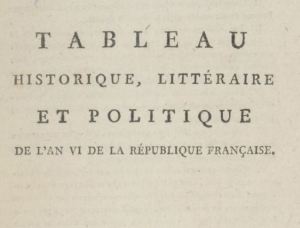
(You can almost feel the rich texture of the paper.)
And then, the first chapter division:
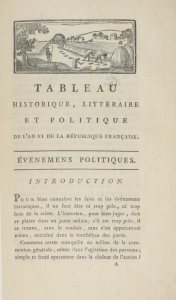
What caught my attention “leafing” through this book was the section on legislation, a daily account of laws passed in the years 1798-1799.
They are very detailed: they needed to be. The French government was (once again) creating a government from scratch. Laws mentioned cover passport regulations, import duties, the re-establishment of a national lottery, the legislateurs’ own schedule (they will no longer meet on décadis (the end of the 10-day week), patents, manufacture of goods, the “uniform” to be worn by the members of the legislature …
“…habit français, couleur bleu national, croisé et dépassant le genou. Ceinture de soie tricolore, avec des franges d’or. Manteau écarlate à la grecque, orné de broderie en laine. Bonnet de velours, portant une aigrette tricolore.” – page 142
Alas, I am unable to find an illustration of this costume. No doubt they were somewhat more circumspect than those from 1796. Below left, Executive Director from 1796, compared to Napoleon’s uniform of choice as First Consul on the right:
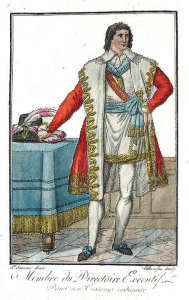
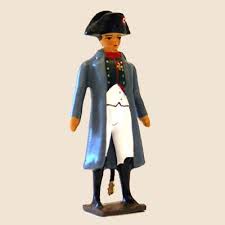
The legal record is many pages long, but I’ll note a few:
One law passed condemns to death those who rob by force or violence. This is significant because violent crime had become rampant.
Marriages (which must be civil) could only be held on décadis.
One significant law, passed 12 Nivose, an VIII (January 1, 1799), declares that Blacks born in Africa or in foreign colonies, and transferred to French islands, were free as soon as they step foot on French soil. The Revolutionary government had several years before outlawed slavery in France, but I don’t believe that it had gone so far as to declare it illegal in its colonies. (I should note that Napoleon will eventually reinstate slavery in the French colonies, and no: it was not Josephine’s doing.)
It’s delightful how worthwhile procrastinating can be. I found an excellent Revolutionary calendar (more on that later), learned the date when there was an eclipse of the moon, what the new national fêtes were to be, and much, much more.
by Sandra Gulland | Oct 24, 2014 | Baroque Explorations |
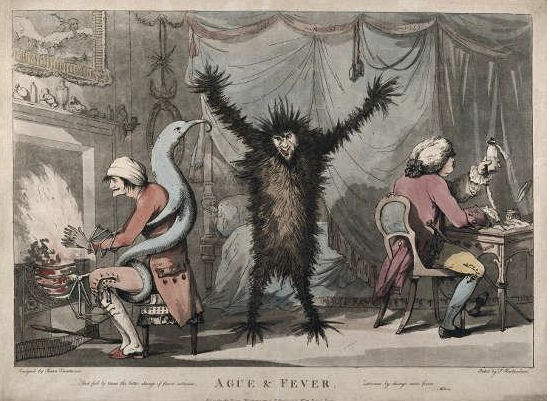
Fear of Ebola is helping me understand how people felt and responded to fear of the plague—the Black Death—in the Napoleonic era.
During Napoleon’s Egyptian campaign, there was an outbreak of the bubonic plague after the French capture of Jaffa on 7 March 1799. The news that there was plague in Egypt must have terrified the families and friends of the soldiers who were fighting there.
This from Wikipedia:
Before leaving Jaffa, Bonaparte set up a divan for the city along with a large hospital on the site of the Carmelite monastery at Mount Carmel to treat those of his soldiers who had caught the plague, whose symptoms had been seen among them since the start of the siege. A report from generals Bon and Rampon on the plague’s spread worried Bonaparte. To calm his army, it is said he went into the sufferers’ rooms, spoke with and consoled the sick and touched them, saying “See, it’s nothing,” then left the hospital and told those who thought his actions unwise “It was my duty, I’m commander-in-chief.”
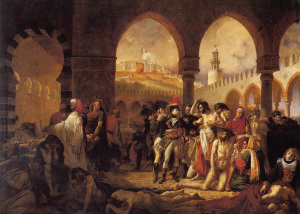
However, some later historians state that Napoleon avoided touching or even meeting plague-sufferers to avoid catching it and that his visits to the sick were invented by later Napoleonic propaganda.
For example, long after the campaign, Antoine-Jean Gros produced the propaganda painting Bonaparte visiting the plague-victims of Jaffa in 1804. This showed Napoleon touching a sick man’s body, modelling him on an Ancien Régime king-healer touching sufferers from the “King’s Evil” during his coronation rites – this was no coincidence, since 1804 was the year Napoleon Bonaparte crowned himself emperor.
Quarantine used to contain the spread of contagious diseases
One way of containing the spread of a highly-contageous disease in Europe was quarantine:
The practice of quarantine, as we know it, began during the 14th century in an effort to protect coastal cities from plague epidemics. Ships arriving in Venice from infected ports were required to sit at anchor for 40 days before landing. This practice, called quarantine, was derived from the Italian words quaranta giorni, which mean 40 days.
When Napoleon returned to France from Egypt, landing in Fréjus, he was criticized for not having observed the obligatory quarantine imposed on people coming from a plague-infected country. The breech of the quarantine laws was no small matter: it was punishable even with death.
According to Napoleon’s secretary Bourrienne, however, when the citizens of the village swarmed Napoleon’s boat in their enthusiasm,
In vain we endeavoured to keep the people off; we were fairly lifted up, and carried on shore. When we told the crowd of men and women the danger they ran [of contracting the Plague] they all cried out, “We’d rather have the plague than the Austrians.”
And later:
When we consider that 500 people landed and all the goods brought from Alexandria, where the plague had been raging during the summer…[it was fortunate] that France and Europe were spared.
Related links
On Ebola quarantine today and in years past: Ebola is ‘Jerking Us Back to the 19th Century

Entire City Quarantined in China After Man Dies of the Bubonic Plague
Feeling Swinish: Or the Origins of “Pandemic”
Painting at top: Napoleon visiting the plague victims of Jaffa, by Antoine-Jean Gros.
by Sandra Gulland | Oct 18, 2014 | Baroque Explorations |
I have been falling victim to research excitement. On one search, I came upon these letters, which did not answer my questions, but were too exciting to pass by.
All of the letters are part of an auction of letters and manuscripts. The first two were dictated by Napoleon to Géraud Christophe Duroc, displaying Duroc’s lovely handwriting. Since he is a significant character in the Young Adult novels I am writing, seeing his graceful, elegant handwriting speaks volumes.
This first one was written on November 13, 1796, in Verona. (See here for details.)
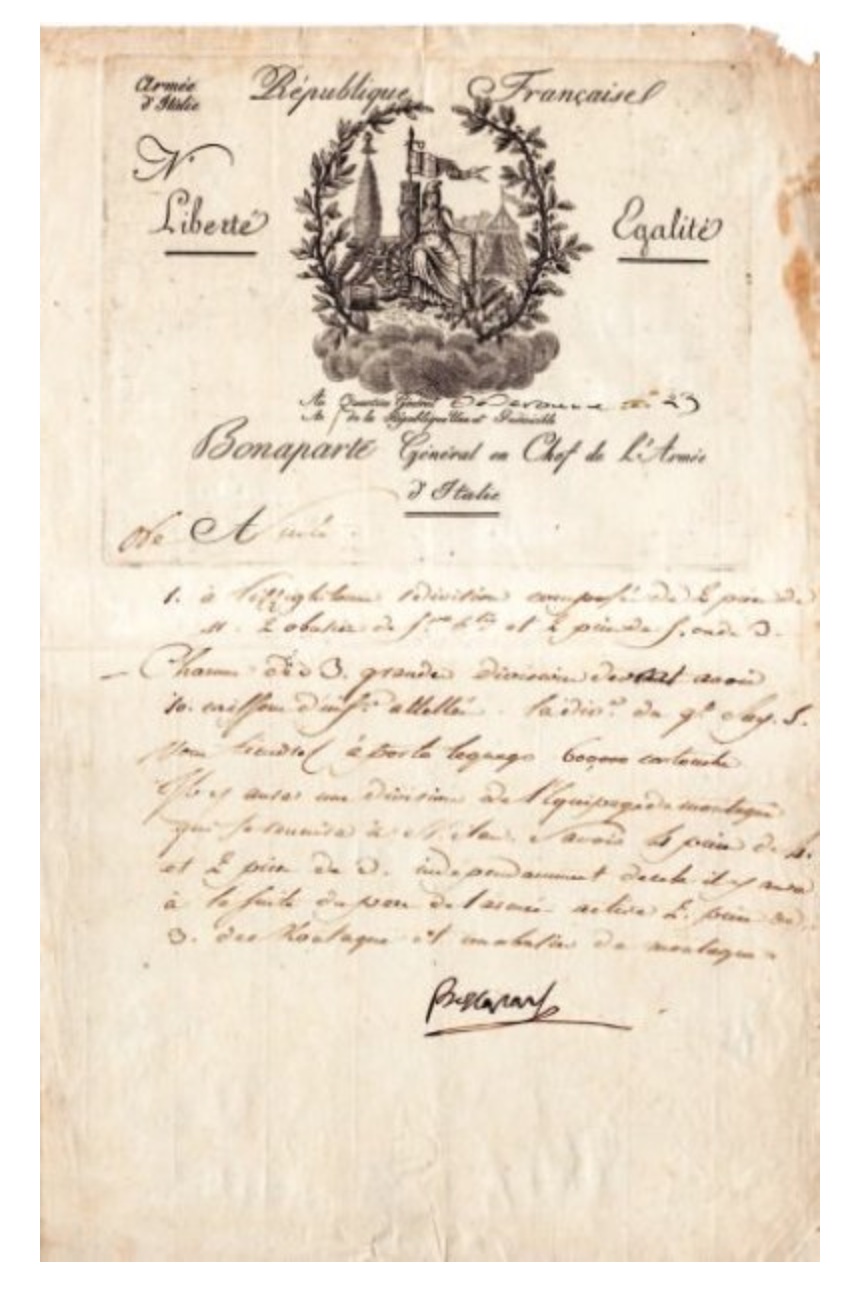
This second letter, also dictated by Napoleon and written by Duroc, was sent on September 30, 1797, from Passeriano, Italy, during the peace negotiations with Austria.
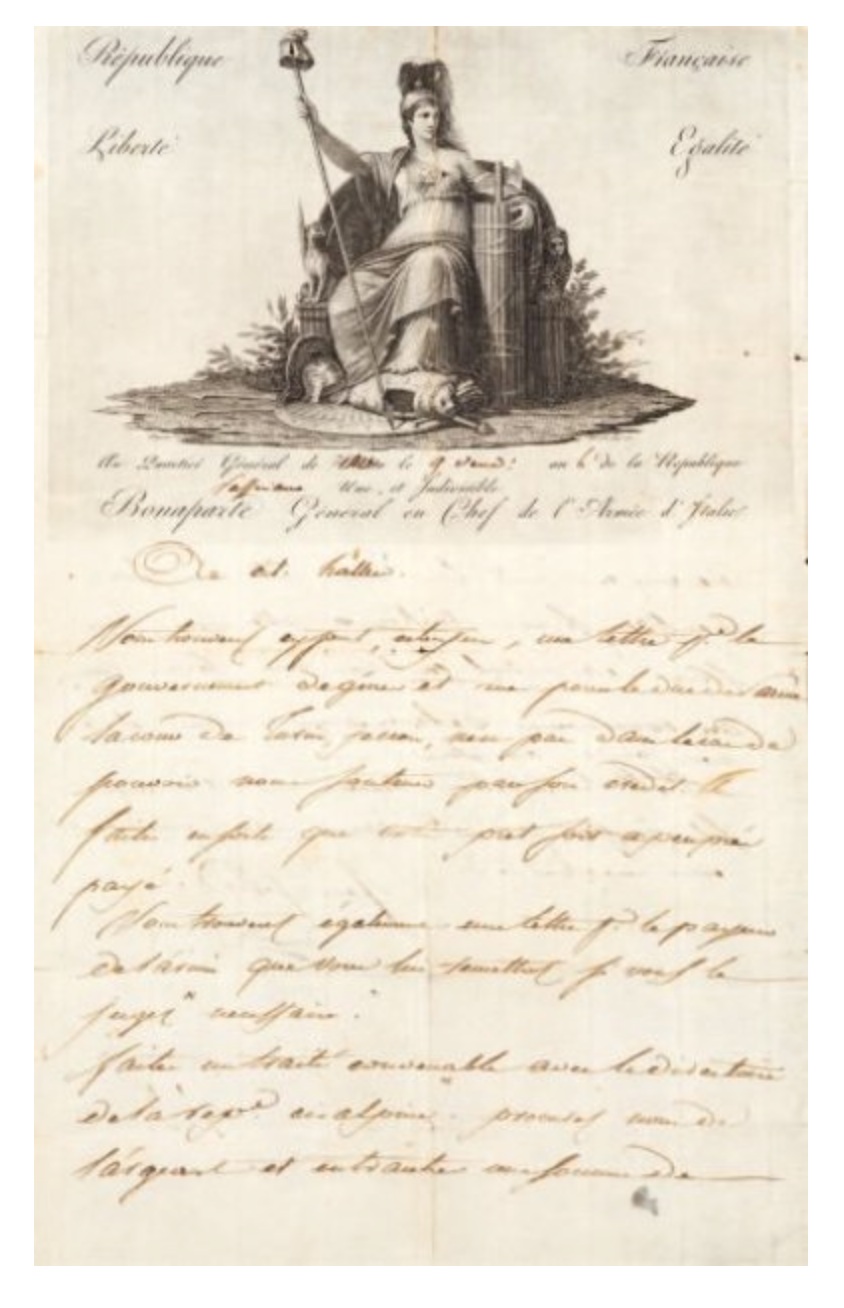
This next letter was written by Napoleon to his brother Joseph in October of 1792 from Ajaccio, Corsica, and it helps understand why Napoleon had need of a secretary. Napoleon’s handwriting was famously difficult to read.
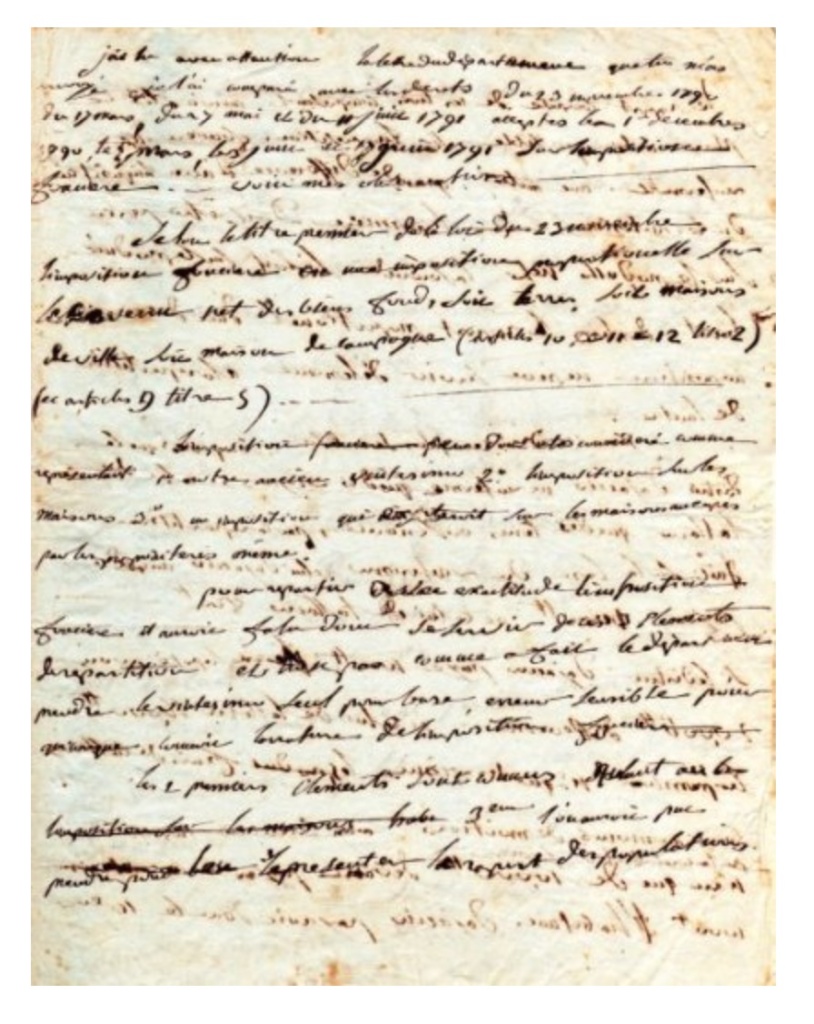
This last one was written by Josephine on May 14, 1809, to her son Eugène.
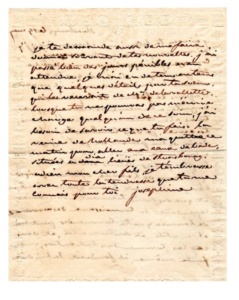
It simply thrills me to see her signature.
by Sandra Gulland | Oct 18, 2014 | Baroque Explorations |
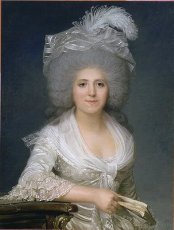
It continues to amaze me what one can find on-line now. I was searching for pre-1805 publications that contained the name Madame Campan, the founder and director of the highly esteemed boarding school Josephine’s daughter, Hortense de Beauharnais, went to.*
I was charmed to find Madame Campan’s name listed in this title:

At the beginning of the Mémoires is thank you note to the subscribers, a very long list which includes many members of the Court (including the King and Queen). I gather that all these people paid in advance in order for the Mémoires to be published. This reminded me immediately of our on-line crowdsourcing like Kickstarter.
Plus ça change, plus c’est la même chose.
*I was on-line trying to find out the name of the school as it had been referred to at the time. Here are two possibilities:
L’Institut National des Jeunes Filles/National Institution for Young Women
I’ve also seen (but only in English): National Institution for the Education of Young Women.
l’Institut national de Saint-Germain/The National Institution of Saint-Germain
I have doubts about this name because during the Revolution the name of Saint-Germain-en-Laye had been changed to Montagne-Bon-Air. It was changed back 28 février 1795, but would Madame Campan have been so bold as to jump immediately on the reversal?
by Sandra Gulland | Sep 14, 2014 | Baroque Explorations |

I began this essay on the Statue of Liberty October 28, 2012—which, coincidentally, happened to be the statue’s 126th birthday. It was also the day the statue was scheduled to reopen after renovations. Days later, Hurricane Sandy hit New York, and two images were often seen on the Net. They aren’t authentic images, in fact, but they poetically capture a greater truth—the image of endurance in the face of tremendous challenge.

Endurance in the face of challenge was what it took to create the statue, in fact. It’s a fascinating and inspiring history, demonstrating how a few persistent individuals can effect great change.
How does the Statue of Liberty survive a storm?
Although the storm did damage Liberty and Ellis Islands, there was no damage to the statue. How did Lady Liberty survive? The key is in how she was designed—by Monsieur Eiffel, creator of the Eiffel Tower in Paris.
My fascination with Lady Liberty began in Paris, when my husband and I went to the Musée des arts et métiers. The museum is a wonderful display of the history of innovation, mostly from the 18th century. One thing that particularly struck me were the mock-ups of the work site of the Statue of Liberty being built.
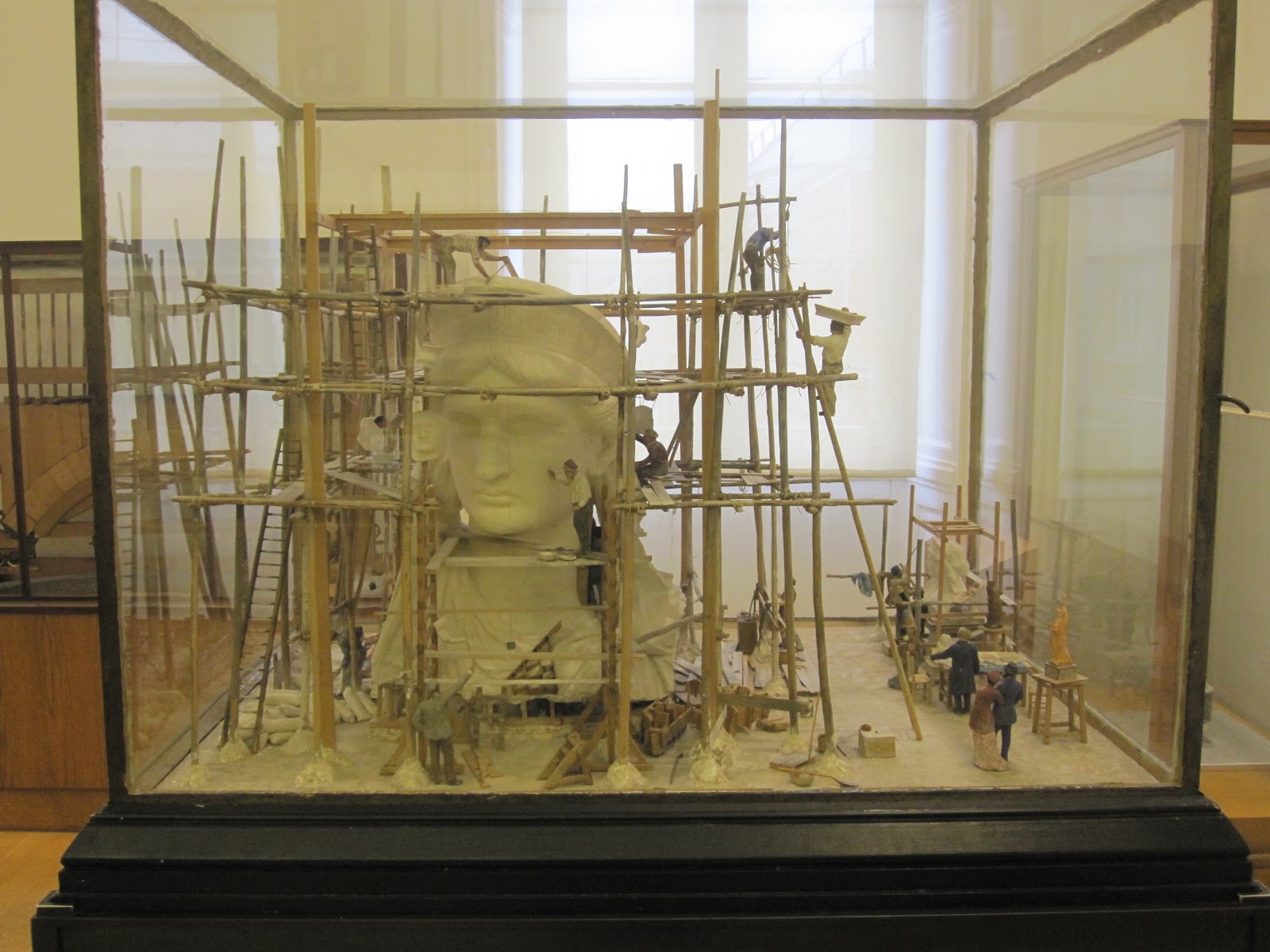
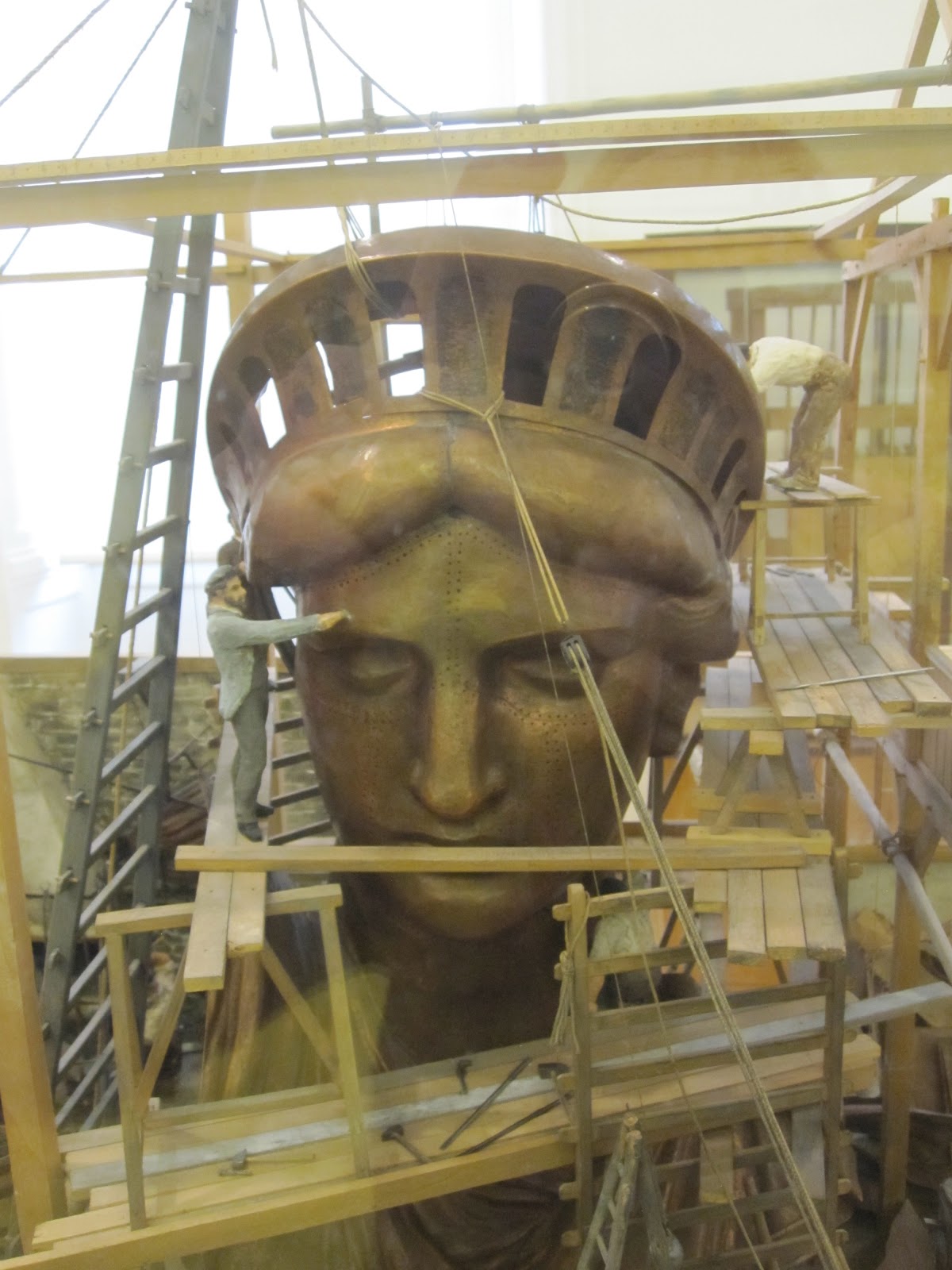
(The face of the Statue of Liberty is touchingly modelled on that of the sculptor’s mother.)
The statue began as most great projects do: as a bright light of an idea in one person’s mind. Frédéric Bartholdi, a French sculptor, thought it would be a wonderful way to commemorate the centennial of the American Declaration of Independence. Happy Birthday, U.S.A.*
A wonderful idea, but a problematic gift
The project proceeded in an equally typical fashion: with great frustration and wrangling. Did America even want such a gift? Where would they put it? And more to the point, who would pay for it?
It was eventually agreed that the U.S. would build the pedestal, and France the statue. A huge sum of money was required, and on both sides of the ocean fees, fund-raisers, auctions, and lotteries were used to try to raise the needed funds.
Little by little, things were set in motion. Frédéric was commissioned, and wisely chose Alexandre Gustave Eiffel, designer of the Eiffel Tower, to design the support structure. Eiffel opted not to use a rigid structure, but instead loosely connected the support structure to the skin. It’s this flexibility what allows the statue to endure high winds.
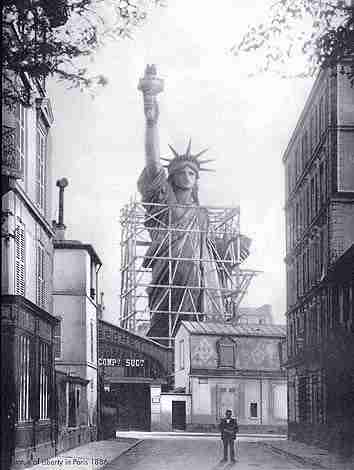
Fund-raising for the pedestal lagged in America, however, and work was suspended. Other American cities, including Boston and Philadelphia, offered to pay in return for relocating it. Joseph Pulitzer (founder of the Pulitzer Prize), publisher of a New York newspaper, announced a drive to raise $100,000 (the equivalent of $2.3 million today) by pledging to print the name of every contributor in the paper, no matter how small the amount, along with the touching notes he received:
“A young girl alone in the world” donated “60 cents, the result of self denial.”
“Five cents as a poor office boy’s mite toward the Pedestal Fund.”
A group of children sent a dollar as “the money we saved to go to the circus with.”
A dollar given by a “lonely and very aged woman.”
A kindergarten class in Davenport, Iowa, mailed the World a gift of $1.35.
Donations flooded in and work on the pedestal was resumed.
The Statue of Liberty crosses the ocean
Once the pedestal was completed in America, Lady Liberty’s 350 pieces were packed into 214 crates and loaded onto the frigate “Isere.” It took four months to assemble her, and on October 28, 1886, she was officially “born” in a ceremony in front of thousands.![]()
On the morning of the dedication, a parade was held in New York City. As the parade passed the New York Stock Exchange, traders threw ticker tape from the windows—the first ticker-tape parade.
At the unveiling ceremony, creator Frédéric was called upon to speak, but refused. Was he too moved? It had taken over two decades of his persistent effort, and his dream had finally become a reality.
It’s such a wonderful story. After visiting that museum, I began to take notes for a possible children’s book on Lady Liberty’s amazing voyage.
* Lawyer and politician Édouard de Laboulaye was also an important part of the statue’s conception and creations, but for the purpose of this essay, I’ve focussed on Frédéric.
Painting above: Unveiling of the Statue of Liberty Enlightening the World by Edward Moran.
by Sandra Gulland | Sep 6, 2014 | Baroque Explorations |
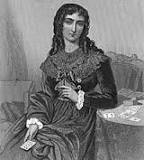
Part of my research for writing my first Young Adult novel about Josephine‘s daughter Hortense involves fortune-telling, mysticism and communing with ghosts. Yes, all quite delicious!
Madame Lenormand (or Le Normand) was a famous fortune-teller of this time, a high-society favourite known as “The Sibyl of the Faubourg Saint-Germain.”
A card method of fortune-telling attributed to her is extremely popular now. Type “Lenormand” in Google and you will see what I mean. The Madame Lenormand Fortune Teller is a site where you can get a (free) reading on-line using a variety of cards: fairly awesome! This is a great way to get to know the cards and the different ways of reading them.

At the Lenormand on-line Museum you can look at all the cards, both ancient and new.
Once you start exploring this realm, it’s a bit overwhelming. I appear to have just signed up for a free telephone reading! I’m no sibyl, but I predict that they will want my credit card number first.
For more on this subject: Origins of Playing Card Divination.
Since writing this post, I’ve learned a great deal more about Madame Lenormand and her cards. For one thing, she was quite the entrepreneur, writing and publishing vast amounts. I read several books on her system, and made a practice of “throwing” my cards every day. In short, I became a bit addicted! The cards are often called “The Game of Hope”—and they’ve become central to the novel I’m writing. In fact, the working title is The Game of Hope.
Books about The Game of Hope:

For information about Lenormand: A Wicked Pack of Cards by Ronald Decker, Therry Depaulis and Michael Dummett.

To learn how to read the cards, I like The Secrets of the Lenormand Oracle by Sylvie Steinbach.

Another book, a bit more complex however, is Learning Lenormand by Marcus Katz and Tali Goodwin.




























